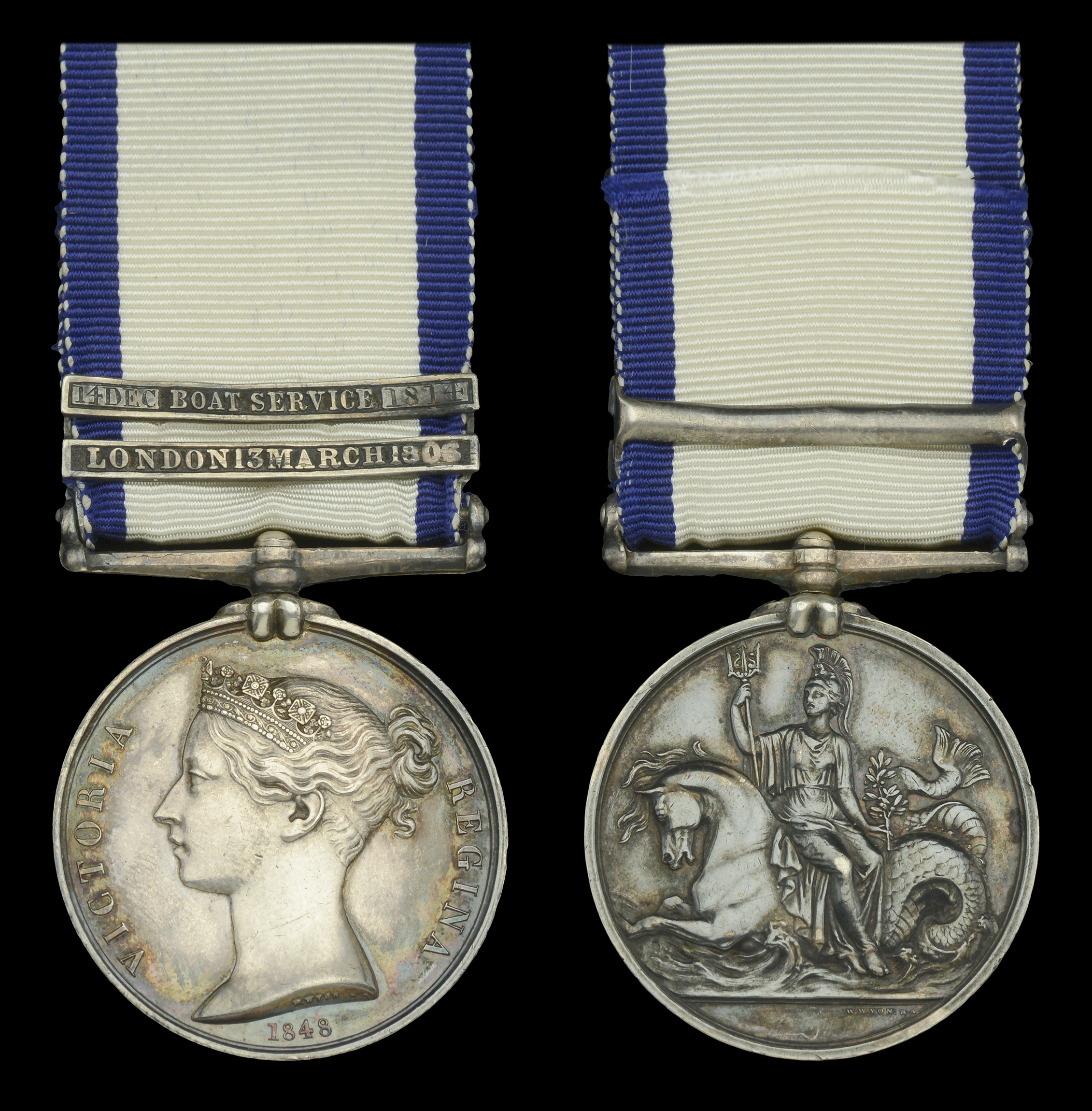The 2-clasp Naval General Service medal awarded to Terence House, a Landsman aboard the London at the capture, in company with the Amazon, of the French 74-gun ship-of-the-line Marengo and 40-gun frigate Belle-Poule in March 1806; and in the boats of the Royal Oak in December 1814 at the capture and destruction of the American flotilla on Lake Borgne Naval General Service 1793-1840, 2 clasps, London 13 March 1806, 14 Dec Boat Service 1814 (Terence House.) the clasp facings a little distorted, otherwise good very fine £8,000-£10,000 --- Importation Duty This lot is subject to importation duty of 5% on the hammer price unless exported outside the UK --- --- Terence House is a unique name on the rolls and is confirmed as a Landsman aboard H.M.S. London at the first and in the same rate aboard the Royal Oak at New Orleans. 27 clasps issued for ‘London 13 March 1806’ and approximately 204 for the American boat service action at New Orleans, this combination of clasps seemingly unique. ‘On the 13th of March, at 3 A.M., as a British squadron, consisting of the 98-gun ship London, Captain Sir Harry Neale, 80-gun ship Foudroyant, Captain John Chambers White, bearing the flag of Vice-admiral Sir John Borlase Warren, and 38-gun frigate Amazon, Captain William Parker, was steering to the southeast, with the wind at west-south-west, two sail at a short distance in the north-east were discovered by the London, then astern and to windward of her companions. The London immediately wore in chase, and made signals to the admiral with false fires and blue lights. In a short time Sir Harry got near enough to open his fire upon the strangers, then on the larboard tack, under all sail, and who were no other than our old friends, the Marengo and Belle-Poule, returning to France from their long eastern cruise. At 5 h. 30 m. A.M. the London got alongside of the Marengo; and the two ships commenced the action, yard-arm and yard-arm. At 6 A.M. the Marengo, unable longer to withstand the London's heavy and well-directed fire, hauled off, and made sail ahead. At 6 h. 15 m. A.M. the Belle-Poule opened her fire upon the lee bow of the London, and received a fire in return, until out of gun-shot ahead. At 7 A.M. the Amazon came up; and, passing the London, overtook, and at 8 h. 30 m. A.M. began engaging, the Belle-Poule. All this while the London had been keeping up a running fight with the Marengo, and she continued it until 10 h. 25 m. A.M.; when, seeing the Foudroyant coming fast up, the Marengo struck her colours to the London; as, about the same time, did the Belle-Poule to the Amazon. The London, out of her 740 men and boys, sustained a loss of one midshipman (William Rooke) and nine seamen and marines killed, and one lieutenant (William Faddy, dangerously), one midshipman (J. W. Watson), and 20 seamen and marines wounded. Her sails, rigging, and masts were also a good deal damaged by shot. The loss on board the Amazon amounted to her first lieutenant (Richard Seymour), one lieutenant of marines (Edward Prior), one seaman, and one marine killed, and five seamen wounded. The gun-force of the Marengo and Belle-Poule was precisely that of their respective classes. The former, when she commenced the action, had a crew, as certified by the captain and his two senior lieutenants, of 740 men and boys; of whom the Marengo had two officers and 61 men killed, and eight officers and 74 men wounded, including among the latter the admiral and his son, severely, and Captain Vrignaud, with the loss of his right arm; total 63 killed, and 82 wounded. The Belle-Poule, out of a crew of 330, similarly certified, lost six men killed and 24 wounded. It may seem singular that these two ships should be so well manned at the end of a three years' cruise, especially when the Marengo, if not the frigate, had sent away two or three prizes. But it is believed that they each had on board a proportion of the crew of the Atalante, the loss of whose ship near the Cape of Good Hope has already been noticed’ (A Naval History of Great Britain, by William James refers).





